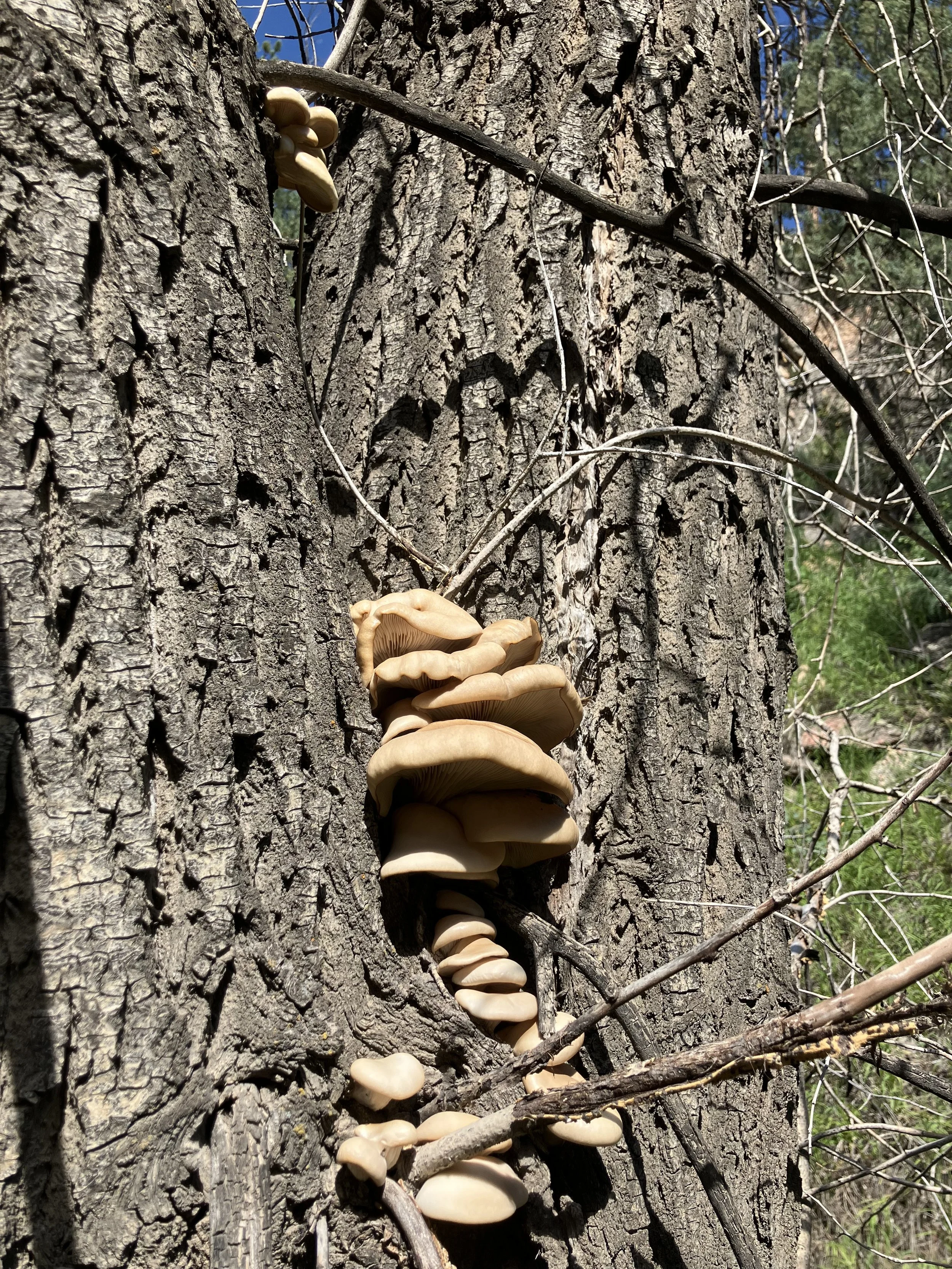Oyster Mushrooms: Wild Abundance & Earthy Grace
Introduction
Oyster mushrooms (Pleurotus ostreatus) are one of the most accessible and beginner-friendly wild mushrooms to forage. I’ve spotted them in a wide variety of habitats from quiet, suburban stumps to deep, pristine woodlands. I was ecstatic to find this particular flush growing alongside a dirt road near Drake, Colorado in late July, at around 8,000 feet.
These gifts of the forest grow in shelf-like clusters. They are soft and inviting, but a note of caution: people with fungal sensitivities may find oysters hard to digest, especially in large amounts. Always try new wild foods slowly and mindfully.
Their adaptability and productivity also make them one of the easiest mushrooms to cultivate at home indoors or on inoculated logs, although we’ll be focusing on the wild foraging details here.
Identification
Scientific name: Pleurotus ostreatus
Mushroom family: Pleurotaceae
Key ID Features:
Grows on wood (especially dead hardwood like cottonwood, aspen, oak, and beech) in overlapping clusters
White to pale gray or tan, fan-shaped caps
Decurrent gills (running down the stem)
No true stem or very short one
Soft, fleshy texture and faint anise or oyster-y smell
Oyster mushrooms produce a white to lilac-gray spore print and have no known toxic lookalikes when properly identified. That said, always forage with care and consult a reliable guidebook or professional. Be especially cautious not to confuse them with Angel Wings (Pleurocybella porrigens) in colder, northern regions. Angel Wings are also considered edible, but are not “choice,” like oysters.
Habitat & Seasonality:
In the Rocky Mountains, oyster mushrooms can fruit from late spring through fall, or really any time the ground is thawed and there’s enough moisture. In warmer temperate regions they can be found year-round. I’ve even seen them growing in the Appalachian Mountains on a dying maple in January!
Foraging Ethics & Safety
Golden rule: When in doubt, leave it out.
Proper identification is essential for your safety and the health of the ecosystem. Always use a reliable field guide or ID app, and take your time observing the growth pattern, habitat, and gill structure.
Harvest Ethically: Three vital (and easy) reciprocity tips
1) Leave the small ones to give younger mushrooms a chance to mature and release their spores. Also, they’re small and wont provide much food.
2) Toss 10% back around other areas of the forest. Throw them or gently place some pieces onto nearby dead hardwood to help spread spores around the forest. It’s a nice way to say thank you and give back to the land you collected from.
3) Use a mesh bag to collect. As you walk, spores naturally fall through and disperse, helping new mushrooms grow inoculate the forest.
⚠️ Avoid foraging near roads, industrial zones, or polluted areas, as mushrooms absorb heavy metals and toxins from their environment.
Optional Tip: Spore Printing
To gain confidence in your ID, try making a spore print. Place the cap of the mushroom gill-side down on a piece of black (or dark) paper, cover with a bowl, and leave it for a few hours or overnight. Oyster mushrooms will leave a white to lilac-gray spore print — a helpful confirmation for beginners.
Storage Tips
Store fresh oyster mushrooms in the refrigerator and use within a few days
For long-term storage, dry them in a dehydrator or low oven
Once dried, store in an airtight jar in a cool, dark place
Shelf life: Dried oyster mushrooms last up to a year
While drying preserves them, fresh preparation is best for flavor and texture
Health Benefits of Oyster Mushrooms
Oyster mushrooms lie more in the food category than medicine, but they pack a powerful nutritional punch. See our simple oyster mushroom recipe here! They’re rich in:
B vitamins
Potassium
Beta-glucans and ergothioneine (powerful antioxidants)
Potential Benefits:
Support immune health
Help manage cholesterol and blood sugar
Reduce inflammation
Promote gut microbiome balance
Offer cellular protection from oxidative stress
Energetics & Ayurveda
While mushrooms are not widely referenced in the classical Ayurvedic texts, they are traditionally considered tamasic, meaning they bring qualities of heaviness, stillness, and grounding. Though tamas is often misunderstood as "bad," it plays an essential role in rest, repair, and deep nourishment. In the right context, tamas can support relaxation, sleep, and recovery.
Ayurvedic energetics of oyster mushrooms:
Taste (Rasa): Sweet
Virya (Potency): Cooling
Vipaka (Post-digestive effect): Sweet
Effect on doshas: Classically, mushrooms are said to provoke all three doshas. Ayurveda does not use mushrooms as medicine, probably due to the tamasic effect. Yet, I find them balancing for Vata and Pitta, slightly building for Kapha
Tissue (Dhatu) support: Nourishes māṃsa dhatu (muscle tissue) and strengthens ojas (vital immunity and resilience)
For those who feel depleted, dry, or overstimulated, oyster mushrooms can offer grounding, strength, and moist nourishment from nature’s forest floor.
Conclusion
Oyster mushrooms are one of the most abundant and accessible edible mushrooms found across a wide range of environments. We explored how to identify them, harvest them ethically, prepare them simply, and appreciate their nutritional and Ayurvedic qualities. Though often overlooked, they offer a delicious, grounding, and immune-supportive food from the wild.
If you're new to mushroom foraging, oyster mushrooms are a wonderful place to begin. Stay curious, harvest responsibly, and always honor the ecosystems that feed you. Good luck foraging!

